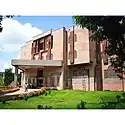Visvesvaraya National Institute of Technology
Visvesvaraya National Institute of Technology (VNIT), formerly Visvesvaraya Regional College of Engineering, Nagpur (VRCE), is a public engineering and research institution in Nagpur, Maharashtra, in central India.[4] It was established in June 1960 by the Government of India and later named in honor of engineer, planner and statesman Mokshagundam Visvesvaraya.
 | |
Former names | Visvesvaraya Regional College of Engineering |
|---|---|
Motto in English | Excellence in action |
| Type | Public engineering college |
| Established | 1960 |
| Chairman | Shri. Vishram Ramchandra Jamdar[1] |
| Director | Dr. P. M. Padole[2] |
| Students | 3716 |
| Undergraduates | 3150 |
| Postgraduates | 705 |
| Location | , , 21°07′24″N 79°03′05″E |
| Campus | Urban 215 acres (87 ha)[3] |
| Website | www |
VNIT Nagpur is centrally funded and belongs to the National Institutes of Technology (NIT) system. In 2007, the institute was conferred the status of Institute of National Importance by an Act of Parliament of India.
The Institute awards Bachelor's, Master's and Doctoral degrees in engineering, technology and architecture, for which the entry is through the Joint Entrance Examination – Mains and Graduate Aptitude Test in Engineering.
History
Unknown to many, the prestigious institute's history can be traced back to 1947, when the Architecture Department was established by Madhya Pradesh Government.
In accordance with the second five-year plan (1956–60) in India, a number of industrial projects were contemplated. The Regional Engineering Colleges (RECs) were established by the central government to mimic the IITs at a regional level and act as benchmarks for the other colleges in that state. For the Western region in the year of 1960, the Institute was established under the name Visvesvaraya Regional College of Engineering (VRCE). It was established under the scheme sponsored by Govt. of India and Govt. of Maharashtra. The college was started in June 1960 by amalgamating the State Govt. Engineering College functioning at Nagpur since July 1956. In the meeting held in October 1962, the Governing Board of the College resolved to name it after the eminent engineer, planner, and statesman of the country Sir M.Visvesvaraya.
The prime objective of establishing Regional Engineering Colleges was to impart quality technical education throughout the country and foster national integration. The College started functioning in 1960 from camp office in the premises of Govt. Polytechnic, Sadar, Nagpur and subsequently an area of about 214 acres was acquired to house an independent Regional Engineering College at present location.
Campus
The VNIT Nagpur campus is located in the western part of Nagpur city near Ambazari Lake, about 7 kilometres (4.3 mi) from Nagpur Railway Station and 8 kilometres (5.0 mi) from Dr. Babasaheb Ambedkar International Airport. There are three main entrances to the 225 acres (91 ha) campus: the Main Gate on South Ambazari Road, the Bajaj Nagar Gate and the Yashwant Nagar Gate. The campus has significant green space, and is mostly untouched by the pollution of the rest of the city.
The Institute has a gymkhana, as well as grounds for tennis, badminton, basketball, volleyball, football, hockey, and cricket. An NCC unit is also located on campus. There is also an auditorium and a medical centre.
Organisation and administration
Departments, laboratories and research centers
VNIT Nagpur has many academic departments, with over 30 specialised laboratories and research centres.[3]
Departments and laboratories
- Applied Mechanics
- Applied Statistics
- Applied and Environmental Microbiology
- Architecture and Planning
- Biomechatronics
- Biomedical Engineering
- Chemistry
- Chemical Engineering
- Civil Engineering
- Computer Science and Engineering
- Computational Physics
- Electrical and Electronics Engineering
- Electronics and Communication Engineering
- Geoscience and Technology
- Geobiology
- Humanities and Social Sciences
- Hydrologic Engineering
- Industrial and Manufacturing Engineering
- Mathematics
- Mechanical Engineering
- Metallurgical and Materials Engineering
- Mining Engineering
- Physics
- Urban Design & Planning
Centers[5]
- Center of Excellence for Commbedded Systems
- Computer Aided Design (CAD)
- Computer Aided Manufacturing (CAM)
- Material Engineering Center
- Center for Remote Sensing
- Center for Water Resources
- Center for VLSI and Nanotechnology
- Incubation Center
Academics
Academic programs
Undergraduate programs are offered in Architecture (B.Arch) and eight engineering (B.Tech) disciplines:
- Chemical Engineering
- Civil Engineering
- Computer Science and Engineering
- Electrical and Electronics Engineering
- Electronics and Communications Engineering
- Mechanical Engineering
- Metallurgical and Materials Engineering
- Mining Engineering
The Engineering undergraduate programs are usually four years, while Architecture is a five-year program. The institute accepts an incoming freshman class of up to 798 students.[6]
Graduate and research programs leading to Master's (M.Arch, M.Sc. and M.Tech) and Ph.D. degrees, are offered by the Architecture department, as well as all basic science departments and all eight engineering departments. A range of special fields of study are available in graduate and research programs in each discipline. The institute will soon offer Aeronautical Engineering. Up to 350 students are admitted to the Master's program each year.[7][8]
The institute uses relative grading on a 10-point scale.
Admissions
Till 2012-13, admission to the undergraduate courses (B.Tech) at NITs was through the All India Engineering Entrance Examination (AIEEE). From 2013-14, admission to the undergraduate courses (B.Tech) is through the Joint Entrance Examination (JEE) Main.[6] The National Institutes of Technology (NITs) have one of the lowest acceptance rates for engineering institutes, around 2 to 3 percent, second only to the Indian Institutes of Technology (IITs) in India.[9][10]
From 2015, the Joint Seat Allocation Authority (JoSSA)] conducts common counselling and allocates seats jointly for all Indian Institutes of Technology (IITs), National Institutes of Technology (NITs) and Indian Institutes of Information Technology (IIITs). In 2015, over 1,300,000 candidates appeared for the JEE exam for admission to 28,000 undergraduate engineering seats (B.Tech) in 68 centrally-funded technical institutes that included all 19 IITs (10,000 seats), 31 NITs (15,500 seats) and 18 IIITs (2,500 seats).[11][12][13]
For B.Tech at VNIT Nagpur in 2015, the acceptance rates were as following:[14][15]
- Computer Science and Engineering: 0.33 percent
- Electronics and Communication Engineering: 0.58 percent
- Mechanical Engineering: 0.67 percent
- Electrical and Electronics Engineering: 0.82 percent
- Civil Engineering: 1.23 percent
- Chemical Engineering: 1.50 percent
- Metallurgical and Materials Engineering: 2.18 percent
- Mining Engineering: 2.61 percent
Undergraduate admissions for foreign students and NRIs are done through Direct Admission of Students Abroad (DASA) scheme which considers SAT scores.
Eighty percent of students to the postgraduate programs (M.Tech) are admitted based on performance in the Graduate Aptitude Test in Engineering (GATE) conducted by the Indian Institutes of Technology (IITs) and the Indian Institute of Science (IISc). These students receive stipends and tuition assistance from the institute and the Indian government. Another 20% of students are admitted based on industry or other research organization sponsorship, with full tuition typically paid by the sponsoring institution.[7]
The institute invites applications for PhD degree admissions in all departments every academic year.
Rankings
| University and college rankings | |
|---|---|
| Engineering – India | |
| NIRF (2020)[16] | 27 |
| Outlook India (2019)[17] | 24 |
VNIT Nagpur has been ranked 27th among engineering colleges in India by the National Institutional Ranking Framework (NIRF) in 2020,[16] and 24th by Outlook India in 2019.[17]
Academic collaboration and sponsored research
The 18th National Seminar on Aerospace Structures (NASAS) was organized by VNIT Nagpur in association with Jawaharlal Nehru Aluminium Research Development and Design Centre (JNARDDC) Nagpur, Aeronautical Research and Development Board (AR & DB), Ministry of Defence, Government of India, New Delhi and Maintenance Command, Indian Air Force, Nagpur.[18]
The institute has academic collaborations with many universities in India and abroad. During 2015 alone, VNIT Nagpur signed 7 memoranda of understanding (MoUs) with international universities and 21 MoUs with national institutions, laboratories and industries.[19][20] These collaborative programmes include student and faculty exchange, internships for students and joint research activities among others. Some of the major universities with an MoU with VNIT Nagpur are:
- Indian Institute of Technology Bombay[21]
- National Institute of Technology, Warangal[22]
- National Institute of Technology Raipur[23]
- National Institute of Technology, Uttarakhand[24]
- College of Engineering, Pune[21]
- Aichi Gakuin University, Japan[25]
- ESIEE Paris, France[26]
- Belarusian National Technical University, Belarus[27]
- Belarusian State University of Informatics and Radioelectronics, Belarus[27]
- New Jersey Institute of Technology, USA
- Beijing Normal University, China[28]
- Hunan University, China[28]
- Southwest University for Nationalities, China[28]
- Jiangshu University, China[28]
- ISAN Medical Institute, South Korea[24]
VNIT Nagpur was one of 12 institutes selected by the MHRD, Government of India, for the BRICS Network University on behalf of India. The institute was identified for the knowledge field ‘Ecology and Climate Change’ and participated in the Indian delegation that attended the Conference of the BRICS held at Ekaterinburg, Russia. A special protocol to the MoU on the establishment of the BRICS Network University was signed by Dr Narendra Chaudhari, Director, VNIT Nagpur.[29]
Departments of the institute are involved in various research projects funded by the Department of Science and Technology (India) and other public and private corporations. VNIT Nagpur has been granted a World Bank assisted technical project for Applied Research in Combedded Systems with the status of Center of Excellence (CoE) under the Technical Education Quality Improvement Programme Phase-II (TEQIP-II).[30] This program includes a grant of Rs. 5 crore. This is one of six National Institutes of Technology centers which have the status of Center of Excellence.
VNIT Nagpur has also partnered with IIT Bombay and the College of Engineering Pune in an R&D project in "Biomedical Engineering and Technology Center Incubation" costing Rs. 39.4 crore.[21]
The institute will soon have a state-of-the-art research laboratory for robotics on its premises as per a pact with the Switzerland-based robotic technology bellwether, Asea Brown Boveri (ABB).[31]
A team from the faculty of Applied Mechanics (structural dynamics and earthquake engineering) at the institute was asked by NGO SEEDS to visit Nepal in the aftermath of the earthquake in 2015 to provide technical support.[32] The team from the department had earlier visited Gujarat when an earthquake struck the state in 2001 and the Andaman and Nicobar Islands in 2004 when a tsunami struck there after a massive quake in Sumatra, Indonesia.[32]
Nagpur Metro Rail Corporation Limited (NMRCL) has joined with VNIT Nagpur for testing facilities and inputs on the metro's structural drawings, inspection and testing of materials.[33]
VNIT Nagpur has adopted nine villages in Amravati, Nagpur and Jalgaon districts under the Unnat Bharat Abhiyan (UBA) aimed at bringing grassroots changes in rural areas through technological interventions from academic and research institutes, without affecting the local culture.[34]
Student life
Festivities
The students club hosts a number of annual events, inviting participants from colleges across the nation. These include:
- Axis, a science and technology festival
- Aarohi, a music and cultural festival
- Consortium, an entrepreneurship summit
Notable Alumni
- Neelam Saxena Chandra - poet and author
- Satyendra Pakhale - industrial designer
- Sudev Nair - actor
- Vijay P. Bhatkar - scientist, Padma Bhushan and Padma Shri awardee, founding director of Centre for Development of Advanced Computing
- Samir Barua - former director Indian Institute of Management, Ahmedabad
- Budaraju Srinivasa Murty - director, Indian Institute of Technology Hyderabad
- Ramesh Jain - professor of Information & Computer Sciences, University of California, Irvine
- Nemkumar Banthia - professor of civil engineering at the University of British Columbia and CEO of IC-IMPACTS
- Akhilesh K. Gaharwar - professor of Biomedical Engineering, Texas A&M University.
- Pradeep Kar - chairman and founder, Microland
- Dinesh Keskar - senior vice president of sales in Asia-Pacific and India at Boeing Commercial Airplanes
- Hemant Karkare - late chief of Mumbai Anti-Terrorist Squad
- Sanjay Joshi - former member of the Bhartiya Janata Party national executive; Rashtriya Swayamsevak Sangh Pracharak and Hindu fundamentalist
- Anand Teltumbde - scholar, writer, and civil rights activist who is a management professor at the Goa Institute of Management
References
- "Chairman". www.vnit.ac.in. Retrieved 7 December 2017.
- "Director". www.vnit.ac.in. Retrieved 7 December 2017.
- "Campus Information". VNIT. Retrieved 10 August 2011.
- "Best engineering colleges in India". pickacollege.digit.in. Retrieved 26 April 2016.
- "Departments". vnit.ac.in. Retrieved 29 April 2016.
- "Undergraduate Programs". VNIT. Retrieved 11 August 2011.
- "Postgraduate Programs". VNIT. Retrieved 11 August 2011.
- "Ph.D. Programs". VNIT. Retrieved 11 August 2011.
- "IIT, NIT admissions 2015: Results of fourth round of seat allotment : Notification". indiatoday.intoday.in. Retrieved 2 May 2016.
- "13 lakh students to appear for JEE (Main) test today - Times of India". The Times of India. Retrieved 2 May 2016.
- "IIT, NIT admissions 2015: Results of fourth round of seat allotment : Notification". indiatoday.intoday.in. Retrieved 1 May 2016.
- "13 lakh students to appear for JEE (Main) test today - Times of India". The Times of India. Retrieved 1 May 2016.
- "JoSAA". josaa.nic.in. Retrieved 1 May 2016.
- "NIT Nagpur Cutoff 2015 | College Pravesh". College Pravesh. 19 November 2015. Retrieved 3 May 2016.
- "13 lakh students to appear for JEE (Main) test today - Times of India". The Times of India. Retrieved 3 May 2016.
- "National Institutional Ranking Framework 2020 (Engineering)". National Institutional Ranking Framework. Ministry of Education. 11 June 2020.
- "India's Top 150 Engineering Colleges In 2019". Outlook India. 6 June 2019.
- "18th National Seminar on Aerospace Structures inaugurated at VNIT". www.nagpurtoday.in. Retrieved 6 May 2016.
- "Welcome VNIT" (PDF). vnit.ac.in. Retrieved 1 May 2016.
- "VNIT's 12th Convocation on September 15". www.nagpurtoday.in. Retrieved 1 May 2016.
- "PNR 5966 - CoEP partners with IIT Bombay and VNIT on an RandD project costing Rs39 39 crore". www.tenderdetail.com. Retrieved 1 May 2016.
- Ramakrishnudu. "MOU-VNIT". www.nitw.ac.in. Retrieved 6 May 2016.
- ":::: National Institute of Technology Raipur ::::". www.nitrr.ac.in. Retrieved 2 May 2016.
- "Welcome VNIT" (PDF). vnit.ac.in. Retrieved 2 May 2016.
- "VNIT and Japan varsity join hands for rural transformation - Times of India". The Times of India. Retrieved 1 May 2016.
- "ESIEE Paris signs three new international agreements in India | ESIEE Paris". www.esiee.fr. Retrieved 25 June 2016.
- "List of Education MoUs signed during President's State visit of Belarus". www.mea.gov.in. Retrieved 1 May 2016.
- "China puts off Jammu-Lanzhou varsity MoU signing". Deccan Herald. Retrieved 25 June 2016.
- "VNIT signs MoU with BRICS Network varsity". www.reacho.in. Retrieved 2 May 2016.
- "VNIT, Nagpur gets Centre of Excellence status, World Bank also grants Rs 5 crore aid". www.resultshub.net. Retrieved 1 May 2016.
- "VNIT to have robotics research centre with ABB - Times of India". The Times of India. Retrieved 2 May 2016.
- "VNIT earthquake engg students, faculty to visit Nepal soon - Times of India". The Times of India. Retrieved 2 May 2016.
- "Nagpur Metro ties up with VNIT, to recruit students too - Times of India". Retrieved 25 June 2016.
- "VNIT adopts nine villages to usher in change through tech - Times of India". Retrieved 25 June 2016.
External links
| Wikimedia Commons has media related to Visvesvaraya National Institute Of Technology. |





